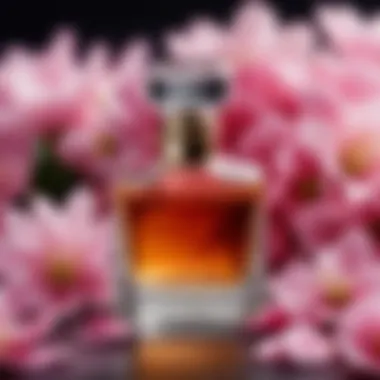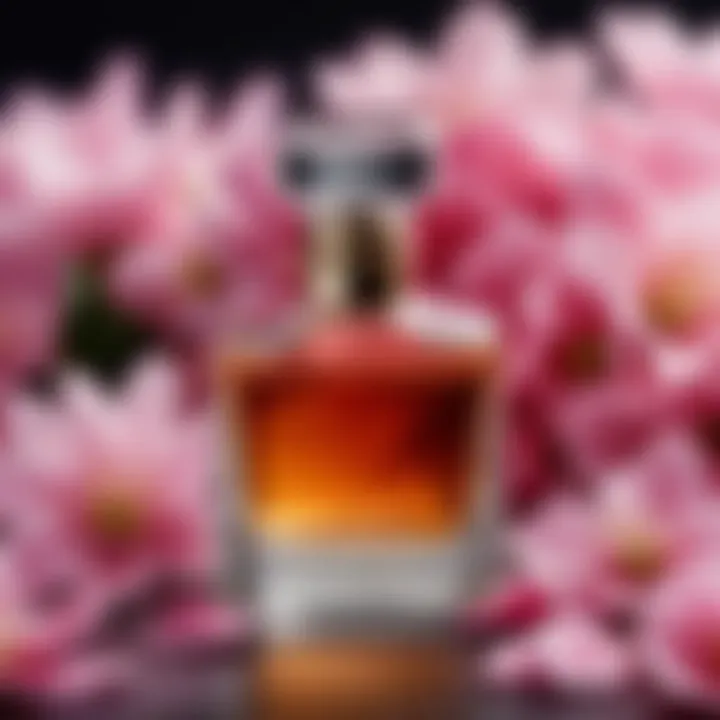Explore the Allure of Floral Perfumes


Intro
Floral perfumes present an intricate universe where each scent tells a story. These fragrances integrate notes from various flowers, creating a rich tapestry of aromas that appeal to a wide audience. The essence of floral perfumes often evokes emotions and memories, forming an intimate connection between the wearer and their choice of fragrance. Since ancient times, these elegant scents have held a significant place in personal care, reflecting cultural significance and beauty ideals.
Importance of Floral Perfumes
The choice of a floral perfume can reveal more than just a preference for a particular scent. It can speak volumes about an individual's personality, mood, and aesthetics. In today's market, hundreds of options are available, appealing to various sensibilities and preferences. Understanding the nuances of floral perfumes can not only enhance the selection process but also deepen the appreciation for their craftsmanship.
In this exploration, we will navigate through key ingredients that define floral fragrances, highlight notable brands synonymous with quality and creativity, and examine modern trends that shape consumer choices. By synthesizing historical context and contemporary insights, readers can make informed decisions about their next fragrance acquisition.
Prologue to Floral Perfumes
Floral perfumes hold a unique place in the fragrance world. Their appeal is broad, capturing the essence of nature through synthetic and natural ingredients. Understanding floral perfumes is essential for anyone aiming to appreciate or select fragrances. They evoke various emotions and memories, making them particularly significant in personal care and beauty routines.
Defining Floral Perfumes
Floral perfumes are predominantly characterized by the presence of flower notes. These scents can range from light and airy to rich and intoxicating. Common floral categories include rose, jasmine, and lily. Each flower brings its own distinct aroma and emotional resonance. Specifically, rose often conveys romance, while jasmine can evoke a sense of calm or sensuality.
In the realm of fragrance, floral scents can be pure or layered with other notes, creating complex and multifaceted compositions. For example, combining floral notes with citrus or woody elements can enhance their aromatic profile, appealing to a wider audience.
Cultural Significance of Floral Scents
Floral scents have transcended time and culture, often associated with important rituals and traditions. Across various societies, flowers have symbolized love, purity, and renewal. In many cultures, gifting flowers is customary during celebrations, as they express sentiments that words sometimes fail to capture.
For instance, in Japan, the cherry blossom, or sakura, embodies beauty and the fleeting nature of existence. Floral perfumes that incorporate such elements connect individuals not only to personal experiences but also to broader cultural narratives.
Floral perfumes can bridge personal and collective experiences, allowing wearers to express their identities while engaging with history and tradition.
In addition, many floral scents serve therapeutic purposes in aromatherapy, where they promote well-being. The calming properties of lavender or the uplifting qualities of ylang-ylang highlight the practical benefits of floral fragrances in everyday life.
To summarize, floral perfumes are more than mere scents; they represent intricate layers of meaning within personal and cultural contexts.
Historical Context of Floral Fragrances
The significance of historical context in floral fragrances cannot be underestimated. Understanding the evolution of these scents offers insights into their role in various cultures, as well as their progression through time. This context informs choices today, connecting past practices with contemporary preferences. Floral perfumes have not only held aesthetic and olfactory appeal but have also been intertwined with social customs, rituals, and even medicinal uses.
Ancient Uses of Fragrance
Historically, the use of fragrance dates back to ancient civilizations where scents were deeply woven into cultural and spiritual practices. For example, Egyptians often used floral oils in religious ceremonies and to embalm the deceased. Flowers like lotus and myrrh were favored for their rich notes and symbolic meanings.
The Greeks and Romans also embraced floral perfumes, viewing them as a luxury. They used various flowers, such as rose and lavender, to create intricate scents. The Romans even established perfumeries, indicating the booming demand for floral fragrances.
- Religious Rituals: Floral scents were frequently employed in temples to honor gods and celebrate seasonal festivals.
- Personal Care: Bathing with fragrant oils became a common practice among wealthy individuals, accounting for skincare and perfume usage.
- Medicinal Properties: Certain flowers were believed to have calming effects, and their oils were used in traditional medicine.
The details illustrate how ancient societies recognized the power of scents, celebrating not just their beauty, but their significance. This historical acknowledgment helps to understand the lasting appreciation for floral perfumes in today's world.
Evolution in Perfume Crafting
The journey of crafting floral perfumes has evolved significantly over the centuries. In ancient times, the process was rudimentary. Natural materials were crushed and blended, relying solely on the qualities of flowers and herbs. As societies advanced, so did the techniques used in fragrance production.
The Renaissance period marked a turning point. New discoveries and trade brought exotic flowers to Europe, and with them, new scent profiles emerged. The introduction of alcohol as a base allowed for more refined and long-lasting fragrances. Eventually, the 19th century brought about the Industrial Revolution, which transformed the perfume industry. Synthetic ingredients became commonplace, enabling perfumers to recreate floral notes that were previously unavailable or hard to obtain.
- Advancements in Chemistry: The creation of synthetic compounds opened avenues for innovative fragrance combinations.
- Artistry and Craftsmanship: The industry shifted towards artistry, with skilled perfumers crafting complex scent profiles through layering and blending.
- Globalization: The exchange of olfactory knowledge across cultures diversified the floral perfume market, leading to a greater variety of choices for consumers.
The evolution of perfumery not only enhances the diversity of floral fragrances available today but also highlights the intricate blend of science and art that defines modern perfume crafting. This historical perspective contextualizes the floral perfume options available to today’s consumers and underscores the relevance of historical practices in contemporary scent choices.
Key Ingredients in Floral Perfumes
In floral perfumes, key ingredients play a crucial role. They dictate the fragrance's character, longevity, and overall appeal. Understanding these ingredients helps consumers make better choices. Knowing the differences between natural and synthetic components is essential. It allows for an informed perspective on the environmental impact, ethical concerns, and individual preferences regarding scent.
Natural vs. Synthetic Ingredients


The debate between natural and synthetic ingredients has gained traction. Natural ingredients come from plants and flowers. They often offer a rich sensory experience. However, they can be unpredictable in scent profile and longevity. Synthetic ingredients provide consistency and lower costs. They can also reproduce scents that might be rare or endangered.
In selecting a floral perfume, one should consider their priorities. Some may prefer the authenticity of natural materials. Others might value the reliability of synthetics.
Common Floral Notes
Floral notes are the backbone of any floral perfume. They create the distinct aroma that defines the genre. Among these notes, certain flowers are especially significant.
Rose
Rose is often called the queen of flowers in perfumery. Its complex scent can be both romantic and fresh. The presence of rose in a composition adds depth. It is beneficial due to its versatility. Rose blends well with many other notes without overpowering them.
However, rose can be expensive, especially when obtained naturally. This expense may limit availability. Still, its iconic status keeps it in high demand.
Jasmine
Jasmine brings a rich, exotic fragrance that is intriguing. It is known for its intoxicating scent, often associated with romance and passion. Jasmine's warm and sweet notes introduce softness to a perfume.
This flower is also commonly used in evening perfumes. Yet, high-quality jasmine oil can be pricey. This is worth noting for budget-conscious shoppers.
Lily
Lily is another key player with a clean, elegant scent. It can brighten any composition with its fresh aroma. The distinctiveness of lily provides a different texture when layered with other florals.
Some people find lily's scent too strong, making it less desirable for everyday wear. Balancing it with softer notes is usually a good idea.
Peony
Peony exudes a soft, floral sweetness that enchants many users. Its lightness makes it ideal for spring and summer fragrances. Peony can bring a youthful quality to a perfume.
On the downside, its subtlety may make it less memorable in heavy compositions. This flower thrives best in lighter blends, adding charm.
Violet
Violet offers a delicate and slightly powdery profile. It has a nostalgic quality that many find appealing. Violets can provide warmth and innocence to a fragrance blend.
However, violet's softness may become overwhelmed by stronger notes. It requires careful formulation to maintain balance in a perfume.
The interplay of these notes creates the magic of floral perfumes, where every ingredient contributes to a unique story, enhancing the overall experience.
Popular Floral Perfume Brands
The world of floral perfumes is diverse, filled with options that cater to varying tastes and preferences. Understanding popular floral perfume brands offers significant benefits to enthusiasts and newcomers alike. Each brand embodies a unique philosophy and aesthetic that can profoundly influence fragrance choices. Brands like Chanel and Dior are not just names; they represent an identity, rich history, and particular scent profiles that resonate with consumers.
Renowned houses often emphasize the artistry and craftsmanship behind their fragrances. They invest time and resources in sourcing the finest ingredients and creating unique compositions. Such attention to detail enhances the olfactory experience and fosters a deeper connection between the wearer and the scent.
Choosing a perfume from a well-established brand often assures quality. Many of these brands have spent decades, if not centuries, honing their formulas and refining their techniques. Therefore, you are likely to find a consistent level of excellence when choosing from these labels. Additionally, prestigious brands frequently offer a variety of options, making it easier to find a floral scent that suits individual preferences.
It is equally advantageous to explore emerging niche brands in the perfume sector. These brands often bring innovation and creativity that challenge traditional interpretations of floral fragrances. They frequently use unique formulations and unconventional ingredients that offer an entirely new perspective on scent. The experience of discovering a hidden gem from an emerging niche brand can be particularly rewarding.
In essence, the importance of exploring popular floral perfume brands lies in their ability to enhance your selection process. They serve as a bridge between heritage and contemporary trends, providing options for both classic and avant-garde preferences.
Esteemed French Houses
French perfume houses have long been revered for their contributions to the world of fragrance. Brands like Chanel, Dior, and Guerlain stand at the pinnacle of this industry, each with a storied history that resonates with perfume lovers. Chanel No. 5, for example, remains a timeless classic, renowned globally for its floral and aldehyde notes that redefine femininity.
Dior's J'adore is another exemplary floral fragrance that showcases the brand's commitment to quality and innovation. Blending rich jasmine and rose, it embodies elegance and sophistication. Such fragrances are often viewed as olfactory masterpieces, emblematic of French perfumery's dedication to craft.
Even beyond these iconic brands, many French houses maintain a focus on floral compositions. They emphasize the use of high-quality natural ingredients, often hand-harvested during peak season to maintain freshness. This commitment to authenticity creates scents that transport wearers to vibrant gardens, filled with blooming flowers in various seasons.
Emerging Niche Brands
In contrast to the established French houses, emerging niche brands offer a refreshing take on floral fragrances. These labels often prioritize craftsmanship and creativity over mass-market appeal. Brands such as Memo Paris and Diptyque push the boundaries of what floral perfumes can be, experimenting with unheard combinations and unique presentations.


Niche brands frequently source rare ingredients, leading to unique and personalized scents that distinguish them from mainstream options. For instance, a fragrance from an emerging brand might employ rare flowering plants, resulting in a scent profile that tells a story unlike any other.
Furthermore, these brands often cultivate a strong community following, engaging with consumers through storytelling and shared experiences. By prioritizing artistry over commercialism, they open a path to discovering scents that resonate on a personal level, making the search for the perfect floral perfume an engaging journey in itself.
Scent Profiles and Their Effects
Understanding scent profiles is critical in the evaluation and selection of floral perfumes. Each profile offers distinct sensory experiences that can evoke emotions, memories, and even influence personal perception. When selecting a fragrance, it is essential to recognize how these profiles align with personal taste and occasion.
Fragrance profiles can be categorized primarily into two types: light and fresh scents, as well as rich and opulent compositions. The distinctions between these profiles provide more than just a choice; they open a dialogue between the scent and the wearer’s mood or the impression they wish to convey.
Another aspect to consider is the lasting impact of a scent profile on an individual's presence. Certain profiles can lighten a room or evoke a sense of nostalgia. Thus, awareness of scent profiles is invaluable for those seeking to express themselves through fragrance.
"The olfactory sense is closely tied to memory, making scent profiling a powerful tool in personal expression."
Light and Fresh Floral Scents
Light floral scents are characterized by their airy and vivacious nature. These fragrances often incorporate notes from flowers like jasmine, violet, and lily. They are perceived as bright and uplifting, making them perfect for daytime wear or warm weather.
- Key Characteristics
- Common Uses
- Subtle and delicate
- Invigorating and refreshing
- Ideal for daytime activities
- Often worn in spring and summer months
Due to their lighter nature, these scents are particularly suited for environments where the objective is to foster a refreshing atmosphere. They can also act as mood lifters, creating a serene ambiance throughout the day.
Rich and Opulent Floral Compositions
Contrasting with their lighter counterparts, rich floral compositions convey depth and complexity. These scents typically include heavier floral notes like rose and peony, layered with warm undertones of amber or sandalwood. They are often regarded as more romantic and intimate.
- Key Characteristics
- Common Uses
- Deep and complex layers
- Longer lasting and more powerful
- Best suited for evenings or formal occasions
- Popular during cooler months
Rich floral fragrances have the ability to create a lasting impression. Their opulence can encapsulate the essence of grand events, making them a favorite choice for special occasions or romantic evenings.
Layering Floral Fragrances
Layering floral fragrances is an essential technique for both fragrance enthusiasts and casual users alike. This method allows individuals to create a personalized scent that can reflect their mood, style, or even the season. When done correctly, layering can enhance the complexity of floral perfumes, bringing out subtle notes that might be lost when worn alone. It encourages experimentation and self-expression, offering an opportunity to distinguish oneself in a world of ubiquitous scents.
There are several key benefits to mastering the art of layering. First, it can amplify the longevity of your fragrance. By combining different scents, users can create a lasting impression, prolonging the overall olfactory experience. Second, layering enables one to craft unique combinations that are unlikely to be replicated by others. This originality can become a personal signature, marking a specific charm for the wearer. Finally, it allows for versatility— layering can transform a light floral scent into something richer or more enigmatic, adapting to different settings or occasions.
However, effective layering requires a careful approach. Understanding the characteristics of various floral scents and how they interact with each other is crucial for achieving a harmonious blend.
Techniques for Effective Layering
When it comes to effective layering, consider the following techniques:
- Start with a Base: Begin by applying a neutral base fragrance. This could be a simple musk or a light, clean scent. The base serves as the foundation upon which the floral notes will build.
- Choose Complementary Floral Notes: Focus on floral notes that naturally complement each other. For instance, pairing a rose scent with jasmine can evoke a romantic aura.
- Apply in Stages: Apply each layer gradually to determine how the scents combine. It's wise to start with small amounts to avoid overwhelming the senses.
- Be Mindful of Concentration: Use perfumes with different concentrations. A lighter eau de toilette can provide a subtle undercurrent when layered with a more concentrated parfum, offering depth without clashing.
- Test and Adjust: Each person's chemistry interacts differently with scents. It helps to test combinations and adjust as necessary until you find the right balance that works for you.
Complementary Scents to Pair
Choosing complementary scents is an integral part of layering floral fragrances. Here are some suggestions:
- Rose and Sandalwood: The sweetness of rose can be beautifully rounded by the warm, creamy notes of sandalwood.
- Jasmine and Citrus: The rich, heady character of jasmine can be uplifted by bright citrus notes like bergamot or lemon.
- Lily and Green Notes: Fresh green notes from basil or mint can enhance the crispness of lily, adding an invigorating element.
- Peony and Vanilla: The soft and delicate nature of peony pairs well with the comforting richness of vanilla, providing a balanced and inviting aroma.
- Violet and Tonka Bean: The powdery sweetness of violet can be accentuated by the warm, nutty aspects of tonka bean, creating a heartfelt signature.
Employing these methods can greatly enhance your experience with floral fragrances. The beauty of layering is that it opens up endless possibilities. > "Fragrance speaks the language of the soul. Layering allows us to articulate that language in our own unique way."
By understanding how to blend and pair scents effectively, one can elevate a simple floral fragrance into a complex and personal olfactory statement.
Floral Perfume Trends
Floral perfume trends hold a significant place in the fragrance market. This relevance comes from their ability to reflect changing consumer desires, societal values, and environmental concerns. By analyzing these trends, one can better understand the evolution of floral scents and their growing appeal. As preferences shift, so too do the formulations and offerings within the realm of floral fragrances. In this exploration, we will delve into two crucial aspects of current trends: seasonal variations in scent preferences and the push towards sustainability in perfume production.
Seasonal Variations and Preferences
The aromas that evoke certain feelings often change with the seasons. Florals can vary dramatically in scent profile from spring to winter. In spring, lighter, fresher scents such as lilac and cherry blossom dominate. These scents are seen as rejuvenating, symbolizing the renewal of nature.
As the seasons transition to summer, richer floral fragrances gain popularity. Jasmine and gardenia, for example, are often favored for their lush, intoxicating qualities. These scents are typically heavier and evoke a sense of warmth. In autumn, musky and spicy floral notes can take precedence, with scents like chrysanthemum becoming more desirable. Finally, in winter, fragrances like violet or rose can add warmth and comfort during the colder months.
"Floral perfumes are not just scents; they are seasonal memories packaged in a bottle."
By recognizing these seasonal patterns, individuals can make informed choices about the floral perfumes they select, thus enhancing their fragrance experience throughout the year. This can involve experimenting with different notes that suit the mood or atmosphere of each season. Ultimately, being attuned to these seasonal preferences aids in achieving a more personal connection with fragrance.
Sustainability in Perfume Production
Sustainability in perfume production is rapidly becoming a crucial consideration for both brands and consumers. As environmental awareness grows, so does the demand for fragrances that align with eco-conscious values. People want to wear scents that do not harm the planet. This has led to more brands focusing on sustainable sourcing of raw materials, ethical production methods, and reduced carbon footprints.
The use of natural ingredients over synthetic components is often emphasized as a fundamental part of sustainability in the floral perfume industry. By opting for materials like essential oils obtained from flowers rather than synthetic replicas, brands can reduce the potential negative impact on the environment.
Additionally, many companies are highlighting their commitment to sustainable packaging. Biodegradable materials and recycled content are getting more common. This shift reflects an understanding that consumers are looking for transparency regarding production practices.
By prioritizing sustainability, brands not only contribute to environmental preservation but can also gain consumer loyalty. Modern shoppers appreciate knowing that their choices help in promoting a healthier world. Companies advancing these initiatives are often celebrated and are seen as trendsetters in the floral fragrance market.
Ultimately, the trends in floral perfumes serve as a mirror reflecting broader shifts in consumer behavior, preferences, and priorities in society. The intersection of fragrance and sustainability highlights a burgeoning movement towards a more thoughtful and conscientious approach to beauty.
Choosing the Right Floral Perfume
Selecting the right floral perfume involves more than simply choosing an attractive bottle. It requires introspection regarding your personal taste, an understanding of how fragrance interacts with your skin, and awareness of current trends in the perfume industry. This article section emphasizes the importance of making informed choices in the realm of fragrances, which can significantly enhance your olfactory experience. A right perfume complements one’s personality and can evoke desired emotions, contributing to overall confidence and well-being.
Understanding Personal Preferences
Personal preferences play a pivotal role in selecting a floral perfume that resonates with your identity. It goes beyond the mere allure of scent. You should consider your lifestyle, the occasions you attend, and the emotions you wish to convey through your fragrance. Each individual has unique tastes influenced by their life experiences and environment.
When thinking about personal preferences, you may ask yourself the following questions:
- What flowers do I connect with emotionally?
- Do I prefer light, airy scents or rich, deep floral notes?
- Is my fragrance preference influenced by current trends or seasonal variations?
Identifying these key aspects can narrow down your options, helping you find scents that genuinely resonate.
Testing and Sampling Techniques
To choose the right floral perfume, one must engage actively in the testing and sampling process. Visiting a store and testing various fragrances is crucial. Apply a dot of perfume on your wrist. After some time, observe how the scent evolves. Notes can change hours after application due to factors like body chemistry and the environment.
When sampling, keep these techniques in mind:
- Avoiding Overwhelming Your Senses: Test only a few perfumes at a time to avoid confusion.
- Using Blotter Strips: Spray perfume on a strip first before testing on your skin. This helps in distinguishing between scents.
- Note Taking: Write down your impressions for each fragrance. This helps recall your favorites later on.
"A true understanding of a fragrance goes beyond an initial impression; it requires patience and exploration."
Choosing the right floral perfume is an art that combines personal style, preference assessment, and effective sampling techniques. Each step completes the overall experience, paving the way to finding a scent that embodies who you are.
Culmination: The Allure of Floral Perfumes
Floral perfumes have held a significant place in the world of fragrances for centuries. Their ability to evoke emotions, memories, and even cultural connections underscores their enduring appeal. As explored throughout this article, the charm of these scents often lies not just in their fragrance but also in the stories and history behind each note.
One must consider the intricate craftsmanship involved in creating floral fragrances. The process blends art and science, requiring a deep understanding of both scent composition and consumer preferences. This adds a layer of depth that enhances the perfume experience, allowing individuals to find personal connections in the fragrances they choose.
Key Elements of Floral Perfumes
- Diversity of Scents: The wide range of floral notes—from the lush sweetness of rose to the delicate freshness of lily—provides options suitable for every personality and occasion.
- Cultural Significance: Scents often represent cultural ties or personal memories. Certain floral fragrances can transport individuals to specific places or times in their lives, reinforcing the perfume's allure.
- Personal Expression: Wearing a floral perfume allows one to express individuality and mood. This personal narrative is essential to why people invest in these fragrances.
"A floral fragrance is not merely a scent; it is an olfactory signature that embodies one’s essence and style."
Benefits and Considerations
Choosing a floral perfume is more than a simple purchase. It's about enhancing one’s lifestyle and aligning scents with personal identity. Factors to consider include:
- Skin Chemistry: Perfumes react differently based on an individual's skin type, which can influence how a flower's scent evolves over time.
- Occasion: The intended use of the fragrance, whether for daily wear or special events, plays a key role in selection.
- Seasonality: Certain floral notes are often preferred depending on the season, with lighter scents favored in warmer months and richer varieties in cooler seasons.







